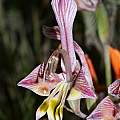From pale rose and mauve to salmon to screaming pink, this color complex offers many shades and the widest range of species in the color indices.
Page 1: G. anatolicus... Page 2: G. carmineus... Page 3: G. densiflorus... Page 4: G. gracilis... Page 5: G. maculatus... Page 6: G. nigromontanus... Page 7: G. phoenix... Page 8: G. saxatilis...
Gladiolus vernus Obermeyer grows in rocky grassland in the Blyde River Canyon area in Mpumalanga. It flowers in July and August in completely dry conditions before the first rain starts. Foliage leaves are produced afterwards in September or October. Flowers are pale to deep pink, or cream, with the upper tepals darker above and with a yellow zone on one or all of the three lower tepals. This zone is sometimes edged with dark pink or purple. The lower halves of the lower tepals are speckled with pink. Flowers are unscented and plants grow from 45 to 75 cm high. Photo from Rachel Saunders.
Gladiolus virescens grows on sandstone or clay slopes in a broad area flowering in late winter to spring. Flowers are yellow to pink with dark veins and very fragrant. The first photo shows a pink one grown by Alan Horstmann and photographed by Bob Rutemoeller. The next two photos were taken by Mary Sue Ittner of plants grown from seed. Photos 4 and 5 were taken by Andrew Harvie at the De Hoop Nature Reserve. The last photo was taken by Rachel Saunders of an unusual color form found flowering in December, much later than the usual time.
Two different color forms were photographed in the southwest Cape September 2003 by Bob Rutemoeller. The next three photos taken by Cameron McMaster at Boskloof and near Napier, both in the Overberg. The last picture shows the seed pods.
Gladiolus virgatus Goldblatt & Manning is restricted to cool, well watered slopes of the coastal ranges of the southwestern Cape. Poorly collected, it has been found in clay soil on ground covered with scattered sandstone boulders. Growing from 30 to 60 cm high, it has linear leaves with slightly thickened margins and midribs. The pale to deep pink or nearly white large unscented flowers are marked on the lower tepals with a spear shaped whitish median streak edged with a reddish v shaped mark, speckled in the throat and are in a two to four flowered inclined spike. The dorsal tepal is inclined over the stamens. This species flowers September-November. The first two photos from Rachel Saunders taken in the Helderberg Nature Reserve. The next three photos from iNaturalist taken by linkie in the same place in November and shared under a CC BY-NC license.
Page 1: G. anatolicus... Page 2: G. carmineus... Page 3: G. densiflorus... Page 4: G. gracilis... Page 5: G. maculatus... Page 6: G. nigromontanus... Page 7: G. phoenix... Page 8: G. saxatilis...
















